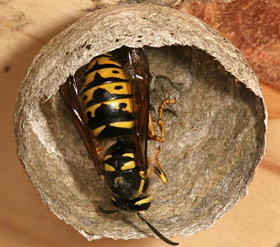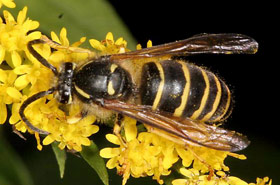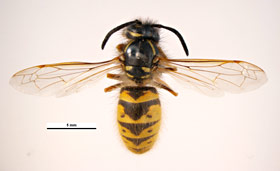Yellowjacket, multiple ground-nesting Vespula species: German Yellowjacket (Vespula germanica), Eastern Yellowjacket (Vespula maculifrons), Common Yellowjacket (Vespula vulgaris), Ground Hornet (Vespula vidua)

German yellowjacket. Photo by Gary Alpert, Harvard University, Bugwood.org.
IPM Steps to Reduce Yellowjackets
1. Sample for Pest
Where to find it while inspecting: These species of yellowjacket wasps are ground-nesters though they will use wall voids as well. Begin in spring to watch for wasp activity and follow them if possible. Look along fence-lines, around playgrounds and structures, and in areas that are very infrequently mowed. Inspect any soil areas that were at one time disturbed or had rodent holes. CAREFULLY look under pieces of wood and other scrap materials that cover soil. Yellowjackets also nest in wood piles, compost piles and stacked straw and hay bales. (While you are inspecting the ground, look up along eaves, covered walkways, trees, outdoor bleachers for signs of aerial wasp and hornet nests.)
2. Proper ID
Size and Particulars: Worker sizes: 1/2–3/4", blunt-abdomen (no slender waist), yellow and black banded with minor differences between species. (Queens are similar in appearance but larger and generally seen only in spring and fall spring).
3. Learn the Pest Biology

Eastern yellowjacket. Photo by Gary Alpert, Harvard University, Bugwood.org.
Life Cycle: Mated females build new nests in spring, lay the first batch of eggs and raise them into adults. This first brood are all female workers and will takeover all work and raising of young. The queen will continue to lay eggs throughout the summer. Late season young mature into new queens and males. Once raising of young is complete workers and mating adults become active outside the next until they die before winter. Only mated females overwinter.
Preferred Food Sources: Adults eat nectar (sugars) but hunt throughout the season for protein sources to feed young. This is most often the larvae of other insects such as soft-bodied caterpillars. As the colony grows, demand grows and you will see many more workers around your own food and garbage containers.
Preferred Habitat: Voids in the ground left by animals or construction or rotting organic matter such as old tree stumps. Any soft soil that is left undisturbed may become a nest site. Carefully consider any area of undisturbed weeds and wild grasses as a possible site.
4. Determine Threshold
Threshold: Indoors—one wasp demands action due to risk for allergic reaction: 1) try to determine how it got inside. Easily through door or window? or from an inside wall 2) keep calm and don’t spray! Outdoors—thresholds are VERY subjective. Action is only necessary if a ground nest is determined to be within twenty feet of any activity area that does not include use of food. If a nest is known to be anywhere near an outdoor eating area or concession stand you may want to act. NOTE: Thresholds vary by time of year, species, and the expectation of disturbance. Foraging wasps may travel up to 3/4 mile (German yellowjacket) so focus on watching for nest activity (busy wasps coming and going from one spot). If you see wasps frequenting a trash can at the rate of ten or more in a ten minute period, you need to act. Wasps are happy to avoid human contact unless you disturb their nest or they perceive a threat while on a food source.
5. Choose Tactics

Common yellowjacket. Pest and Diseases Image Library, Bugwood.org.
Best Management Practices: IPM for wasps includes: inspection, correct ID, monitoring, exclusion, sanitation. First, learn to monitor for new nests before spring and throughout the season. Second, reduce possibility of nesting by sealing entry to wall voids, and removing deadwood BEFORE, not after you have discovered a nest. Third, during spring and early summer, mow with more frequency along edges of lawns, fences and typically unused parts of the campus to make these sites less desirable to queens. Seal open pipes and poles with PRODUCT to block entry ways to larger voids underground. NOTE: mowing or use of string trimmers will often agitate nests yet to be discovered, so start early in the season. Most stings result from unintentional contact with nests.
Treatment Methods: Exclusion: seal any possibly entry site into walls and structures. Check carefully in soil along foundations, fence-lines, and edges of lawn where old posts have been removed or rodent holes may occur—fill them in and compact BEFORE SPRING. Wash down any outdoor tables, trash cans, dumpsters with soapy water frequently in late summer, early fall. If wasps are foraging from an off-site nest and visiting a busy area, you may want to use food-bait traps on poles in an adjacent area to lure away from an activity area, NOTE: you must not have food source available in an area you want to keep wasps from—only at the baited area. See more in our form: TRAPPING STINGING INSECTS. Nest removal: Best left to a professional, but establish a protocol before they are needed. In a case where a nest site can’t be ignored—often when nest is in a wall void, or too close to an activity area. Removal procedures generally include vacuuming and may include an insecticidal dust, but is governed by the pesticide use laws in your district and state. Various other legal use of pesticides by a certified applicator may be needed to treat a nest, and should be done in the evening or early morning, with the least toxic product. Be aware that any treatment is likely to be received as aggression, and a “bee suit” is highly recommended. Leave nest removal to the experts.
6. Evaluate
Was the tactic successful? Record the date pests were first noted, and the tactic you used, and its success. Use one of our RECORD KEEPING tools.
For More Information
Wasp and Bee Management, A Common-Sense Approach. Jody Gangloff-Kaufmann, NYS IPM
Integrated Pest Management for Stinging Insects. Lynn Braband and Jody Gangloff-Kaufmann
Remember:
When a pesticide application is necessary, all necessary and required precautions are taken to minimize risk to people and the environment and to minimize risk of pesticide resistance or pest resurgence. Pesticide use in your school may be prohibited or regulated by local policies or state and federal regulations. Risk reduction methods can include, but are not limited to, spot-treatment, the use of gel or paste bait formulations placed in inaccessible locations, injection into a crack or crevice, and other methods that reduce potential exposure.